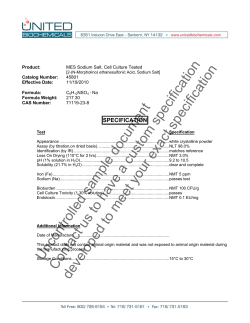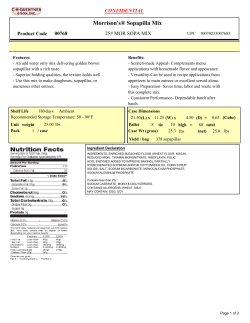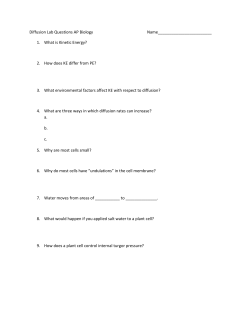
Isotonic and Buffer solutions Dr. Osama A. A. Ahmed
Isotonic and Buffer solutions Dr. Osama A. A. Ahmed Isotonic and Buffer solutions • Colligative properties, From Greek word" collected together”, depend mainly on the number of particles in solution. • They are: vapor pressure lowering freezing point depression boiling point elevation osmotic pressure • Osmosis: 2 solutions of different concentrations are separated by a semi-permeable membrane (only permeable to the solvent) the solvent will move from the solution of lower conc. to that of higher conc. • Osmotic pressure is the pressure that must be applied to the solution to prevent the passage of the solvent through a perfect semipermeable membrane. Dr. Osama A. A. Ahmed 2 Isotonic and Buffer solutions Dr. Osama A. A. Ahmed 3 Isotonic and Buffer solutions • Colligative properties, From Greek word" collected together”, depend mainly on the number of particles in solution. • Nonelectrolytes, the solution will contain only molecules, and the osmotic pressure will vary only with concentration of the solute. • Electrolytes: solution will contain ions, and the osmotic pressure of the solution will vary not only with the concentration but also with the degree of dissociation of the solute. • Isosmotic solutions: solutions that have the same osmotic pressure • Isotonic solution: a solution having the same osmotic pressure as a specific body fluid • Hypotonic solution: a solution of lower osmotic pressure than that of body fluids. • Hypertonic solution: a solution of higher osmotic pressure than that of body fluids. • Important for the pharmacist for preparation of ophthalmic, nasal, parenteral and some rectal preparations. Dr. Osama A. A. Ahmed 4 Dr. Osama A. A. Ahmed 5 Isotonic and Buffer solutions • Calculations for preparation of isotonic solution: • Freezing point depression (colligative properties) • - 0.52 is the freezing point of both blood serum and lacrimal fluids • For nonelectrolytes (negligible dissociation) as boric acid • Boric acid: MWt 61.8 thus if 61.8 g in 1000 g of water should produce a freezing point of -1.86 oC • 1.86 C 61.8 g 0.52 C X g X = 17.3 g • So 17.3 g of boric acid in 1000 g of water (1.73 %) should make a solution isotonic with lacrimal fluid. Dr. Osama A. A. Ahmed 6 Isotonic and Buffer solutions • Calculations for preparation of isotonic solution: • Freezing point depression (colligative properties) • - 0.52 is the freezing point of both blood serum and lacrimal fluids • For electrolytes, it depends on the degree of dissociation • NaCl (M.Wt. 58.5) in weak solutions is 80 % dissociated, then each 100 molecules yields 180 particles, 1.8 times nonelectrolyte. This dissociation factor is symbolized by the letter i . • 1.86 C 1.8 58.5 g 0.52 C X g X = 9.09 g • So 9.09 g of boric acid in 1000 g of water (0.9 % w/v) should make a solution isotonic with blood or lacrimal fluid. Dr. Osama A. A. Ahmed 7 Isotonic and Buffer solutions • Calculations for preparation of isotonic solution: • Isotonic solutions are calculated by the following formula 0.52 molecular weight g of solute per 1000 g of water 1.86 dissociati on i • The value i for many medicinal salts has not been experimentally determined • Some salts as zinc sulfate with 40% dissociation and i value = 1.4 are exceptional. • Most medicinal salts approximate the dissociation of NaCl. • • If the number of ions is known so: Nonelectrolytes and substances of slight dissociation i =1 • • • • Substances that dissociate into 2 ions Substances that dissociate into 3 ions Substances that dissociate into 4 ions Substances that dissociate into 5 ions i i i i Dr. Osama A. A. Ahmed = 1.8 = 2.6 = 3.4 = 4.2 8 Isotonic and Buffer solutions • Calculations for preparation of isotonic solution: • The Sodium Chloride Equivalent (E value) of a drug: is the amount of sodium chloride which has the same osmotic effect as 1 gram of the drug. Mwt of NaCl i factor of subs tan ce Sodium Chloride equivalent i factor of NaCl Mwt ofsubs tan ce • How much NaCl should be used in preparing 100 ml of 1% w/v solution of atropine sulfate, which is to be made isotonic with lacrimal fluids? • M.Wt of NaCl = 58.5, • M.Wt of atropine sulfate = 695, i = 1.8 i = 2.6 695 2.6 1g 58.5 1.8 X g • X = 0.12 g of sodium chloride represented by 1 g of atropine sulfate • Sodium chloride equivalent of atropine sulfate (E value) is = 0.12 (Ch. 11, P. 161) Dr. Osama A. A. Ahmed 9 Isotonic and Buffer solutions • Calculations for preparation of isotonic solution: • For determining the amount of sodium chloride used to cause a solution isotonic, • multiply the quantity of each drug in the prescription by it’s sodium chloride equivalent E , • and subtract this value from the concentration of sodium chloride which is isotonic with body fluids (0.9 gm per 100 ml). • How many grams of sodium chloride should be used in compounding the following prescription • R/ Pilocarpine nitrate 0.3 g • Sodium chloride q.s. • Purified water 30 ml • Make isoton. Sol. • Sig. for the eye Dr. Osama A. A. Ahmed 10 Isotonic and Buffer solutions • Calculations for preparation of isotonic solution: Example: How many grams of sodium chloride should be used in compounding the following prescription R/ Pilocarpine nitrate 0.3 g Sodium chloride q.s. Purified water 30 ml Make isoton. Sol. Sig. for the eye • Sod. Chloride equivalent for Pilocarpine nitrate = 0.23 • 1- 0.23 X 0.3 = 0.069 g of NaCl represented by the pilocarpine nitrate • 2- 0.9 g NaCl Xg X = 0.9 X 30 / 100 = • 3- Dr. Osama A. A. Ahmed 100 ml water to be isotonic 30 ml 0.27 g 0.27 - 0.069 = 0.201 g of sodium chloride to be used 11
© Copyright 2025










